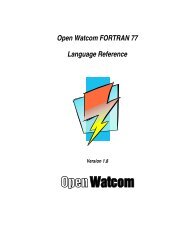Open Watcom Developer's Guide - HEAnet Mirror Service
Open Watcom Developer's Guide - HEAnet Mirror Service
Open Watcom Developer's Guide - HEAnet Mirror Service
You also want an ePaper? Increase the reach of your titles
YUMPU automatically turns print PDFs into web optimized ePapers that Google loves.
Building<br />
6.1 Running the tests<br />
This section maps the major test nests and gives brief description on how to run the tests and<br />
how they’re constructed. There is often a single batch file or script that will build and run all<br />
the tests for a given project, the end result being either "all set to go" or "we have a bug<br />
infestation problem at location xyz, send out bug swat team immediately".<br />
To make automated testing feasible, the test programs do not require user input (unless they<br />
were testing user input of course). Some test programs do their work and then decide whether<br />
everything worked as expected or not and output a message to that effect. Other test programs<br />
ouput messages mapping their progress as they go and the output is then compared with a file<br />
containing the ’good’ output. Which method exactly is used depends mostly on what is being<br />
tested. When testing error and warning messages printed by the compilers and tools, it is<br />
natural to compare the captured output to the expected text. When testing the runtime library<br />
for instance, it makes sense for the test program itself to decide whether the function call<br />
results are what was expected.<br />
Now we’ll go through the projects alphabetically and make a stop whenever there’s something<br />
interesting to see. Note that not all of the tests are automated, the really extensive tests are<br />
however. Being a lazy folk, programmers are likely to bang together an automated test suite if<br />
that helps them avoid babysitting the tests.<br />
as<br />
aui<br />
brinfo<br />
browser<br />
cg<br />
clib<br />
gui<br />
ndisasm<br />
In bld\as\alpha\test there are several tests exercising the Alpha AXP assembler,<br />
using C wrappers for infrastructure.<br />
Not a real test, nevertheless the sample programs in bld\aui\sample are useful in<br />
demonstrating and informally testing the user interface library.<br />
In bld\brinfo\test there is a simple browser information test program.<br />
Tests exercising the class browser are located in bld\browser\test.<br />
In cg\test\far16 there is a test exercising the __far16 keyword. Real code<br />
generator tests are found elsewhere.<br />
The C runtime library tests are located in bld\clib\qa. These tests are not terribly<br />
comprehensive but they do verify the basic C runtime functionality.<br />
Again not a real test, there is a GUI library sample in bld\gui\sample.<br />
Tests for the ’new’ disassembler (not many at this point) are located in<br />
bld\ndisasm\test.<br />
30 Running the tests
















